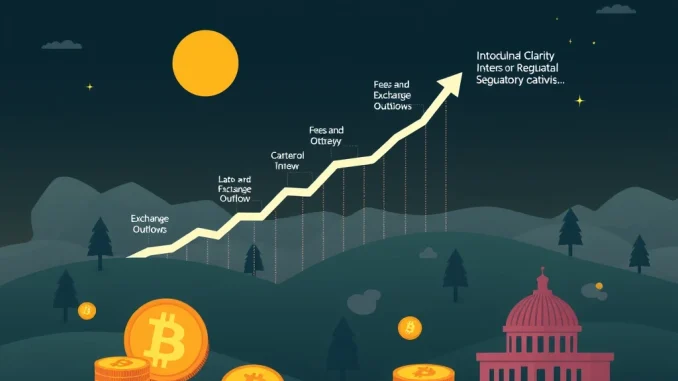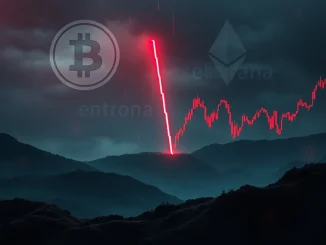
Hey crypto enthusiasts! Ever wonder what those little fees you pay for Bitcoin transactions actually tell us about the market? Well, buckle up, because the latest data is painting a fascinating picture. We’re diving deep into why Bitcoin fees are soaring and what a massive exodus of BTC from exchanges could mean for the future.
Why Are Bitcoin Fees Surging Right Now?
Recent data from the on-chain analytics firm Sentora (formerly known as IntoTheBlock) revealed a significant spike in Bitcoin transaction fees. According to their report shared on X, the total weekly fees collected by Bitcoin miners reached an impressive $6.8 million. This figure represents a staggering 105.8% increase compared to the previous week. So, what’s driving this sudden surge?
Several factors typically contribute to higher Bitcoin fees:
- Increased Network Activity: More transactions mean more demand for block space. When the network is busy, users often pay higher fees to ensure their transactions are processed quickly by miners.
- Specific Transaction Types: Complex transactions, like those involving Ordinals or certain smart contract interactions (though less common on Bitcoin compared to Ethereum), can consume more block space and lead to higher average fees.
- Market Sentiment: During periods of high excitement or volatility, transaction volume tends to increase as traders move funds, driving up fee competition.
Sentora points to two primary drivers for this particular surge: regulatory clarity and high institutional demand. As the regulatory landscape becomes clearer in key markets, institutional players feel more comfortable entering the space. This increased participation often involves large transactions or the movement of significant amounts of Bitcoin, adding pressure to network capacity and boosting fees.
What Does $2.09 Billion in Bitcoin Exchange Outflow Indicate?
Adding another layer to the current market narrative is the substantial amount of Bitcoin leaving centralized exchanges. Sentora’s report also highlighted that a massive $2.09 billion worth of Bitcoin exchange outflow occurred within the same week. This is a significant metric that on-chain analysts watch closely.
Here’s why exchange outflows are often considered bullish:
- Holding, Not Selling: When users withdraw Bitcoin from exchanges to cold storage or private wallets, it typically signals an intent to hold the asset for the long term rather than keeping it on an exchange for potential quick selling.
- Reduced Selling Pressure: Less Bitcoin available on exchanges means there’s less immediate supply that can be easily sold onto the market, potentially reducing selling pressure.
- Institutional Accumulation: Large outflows can sometimes be attributed to institutions or high-net-worth individuals accumulating significant positions and moving them off-exchange for secure custody.
Coupling the high fees (indicating demand for network use) with large exchange outflows (indicating accumulation and holding) paints a picture of strong underlying demand and conviction among Bitcoin holders, especially from larger players.
Decoding Bitcoin On-Chain Data from Sentora
Understanding Bitcoin on-chain data is crucial for gaining deeper insights into the network’s health and market dynamics beyond just price charts. Firms like Sentora specialize in analyzing the publicly available ledger data of the Bitcoin blockchain. They track metrics like transaction volume, active addresses, miner activity, and critically, fee data and exchange flows.
Analyzing this data helps answer questions like:
- Is the network being used more or less? (Look at transaction count, fees)
- Are people accumulating or selling? (Look at exchange balances, wallet flows)
- Are long-term holders moving coins? (Look at UTXO age)
The recent report from Sentora serves as a prime example of how on-chain metrics can provide leading or confirming signals about market sentiment and activity that might not be immediately obvious from price action alone. The surge in fees and the large exchange outflows are concrete, verifiable events on the blockchain.
Connecting to Broader Crypto Market Trends
While this report focuses specifically on Bitcoin, these data points are highly relevant to understanding broader Crypto market trends. Bitcoin remains the dominant cryptocurrency, and its movements and network activity often influence the rest of the market. The institutional interest driving Bitcoin’s fee increase and outflows can have ripple effects across the altcoin landscape.
Consider these connections:
- Increased institutional comfort with Bitcoin can pave the way for interest in other digital assets.
- A strong Bitcoin showing, supported by solid on-chain data, can boost overall market confidence.
- However, high Bitcoin fees can sometimes make smaller transactions or participation in certain activities less economically viable, potentially impacting network usage for certain user groups.
Here’s a quick look at the fee change:
| Metric | Previous Week | Current Week | Change |
|---|---|---|---|
| Weekly Bitcoin Fees | ~$3.3 million (estimated based on 105.8% increase) | $6.8 million | +105.8% |
This dramatic jump underscores the intensity of recent network demand.
Actionable Insights from the Data
So, what can you take away from this? For starters, paying attention to on-chain data from sources like Sentora provides valuable context. The combination of surging fees and large exchange outflows suggests that significant players are actively using the network and moving Bitcoin off exchanges, which is generally interpreted as a bullish signal for long-term price prospects. While past performance is not indicative of future results, these metrics offer insights into current market behavior and potential supply dynamics.
Compelling Summary
In conclusion, the latest data from Sentora paints a compelling picture of robust activity on the Bitcoin network. Weekly Bitcoin fees have more than doubled, hitting $6.8 million, fueled by increased demand likely stemming from growing regulatory clarity and institutional participation. Simultaneously, a staggering $2.09 billion in Bitcoin exchange outflow suggests strong accumulation and a preference for holding over selling. These powerful signals derived from Bitcoin on-chain data, reported by firms like Sentora, are crucial indicators for anyone navigating the current Crypto market trends. They highlight underlying strength and conviction that goes beyond daily price fluctuations, suggesting a market where participants are positioning for the long haul.



